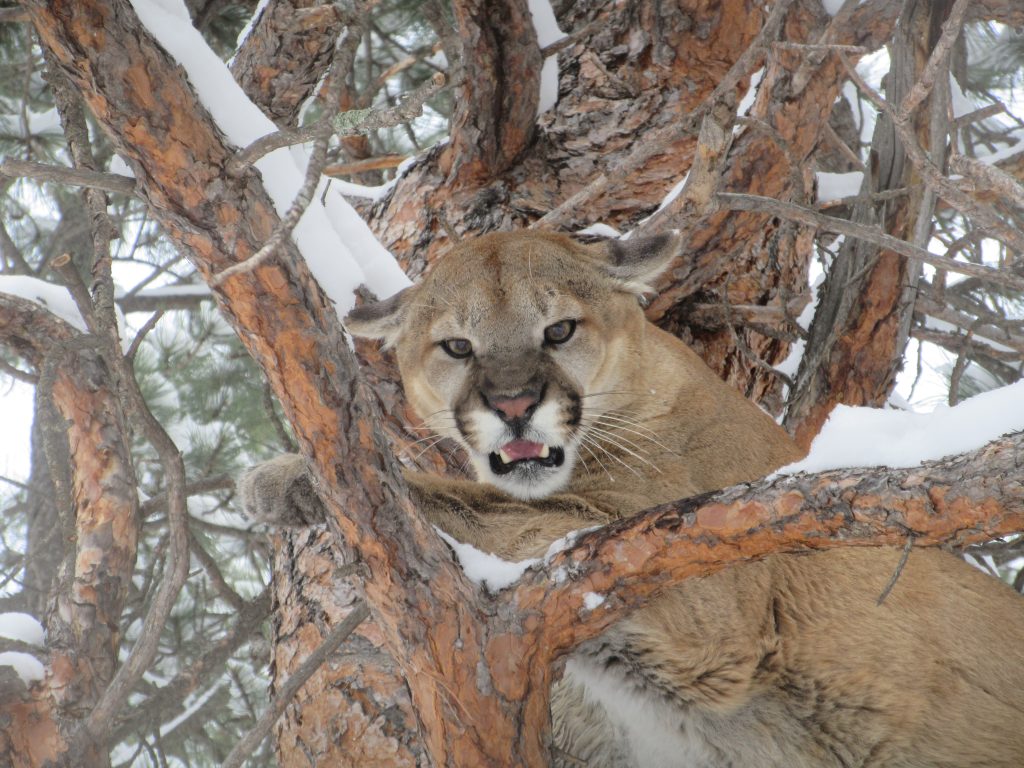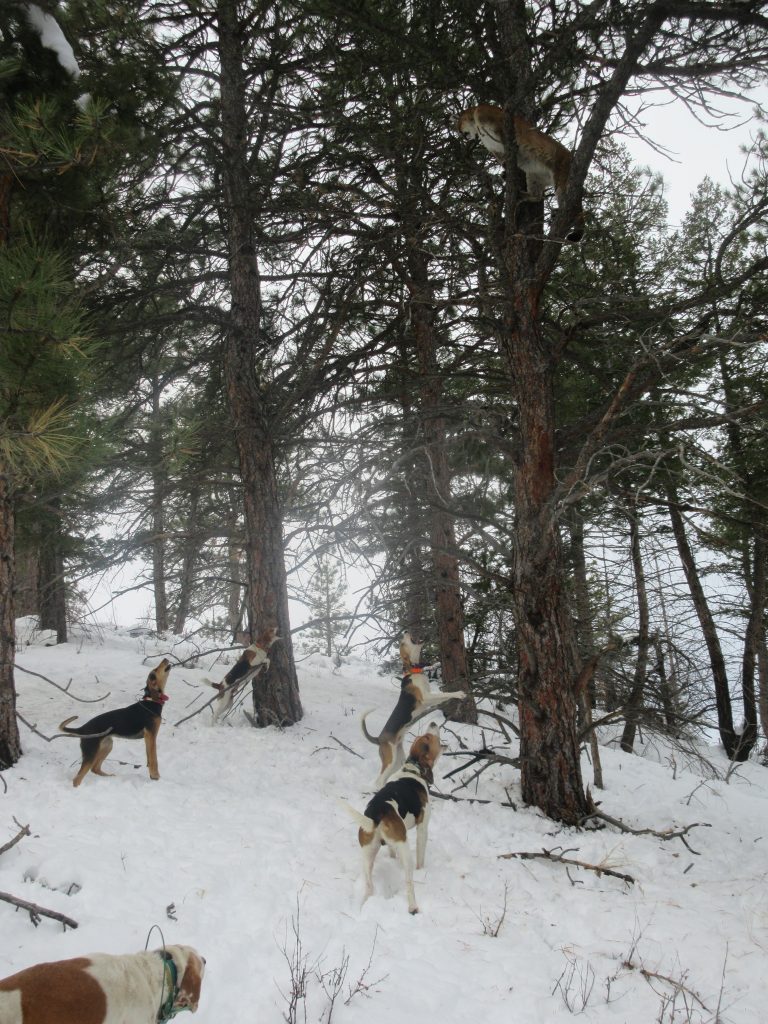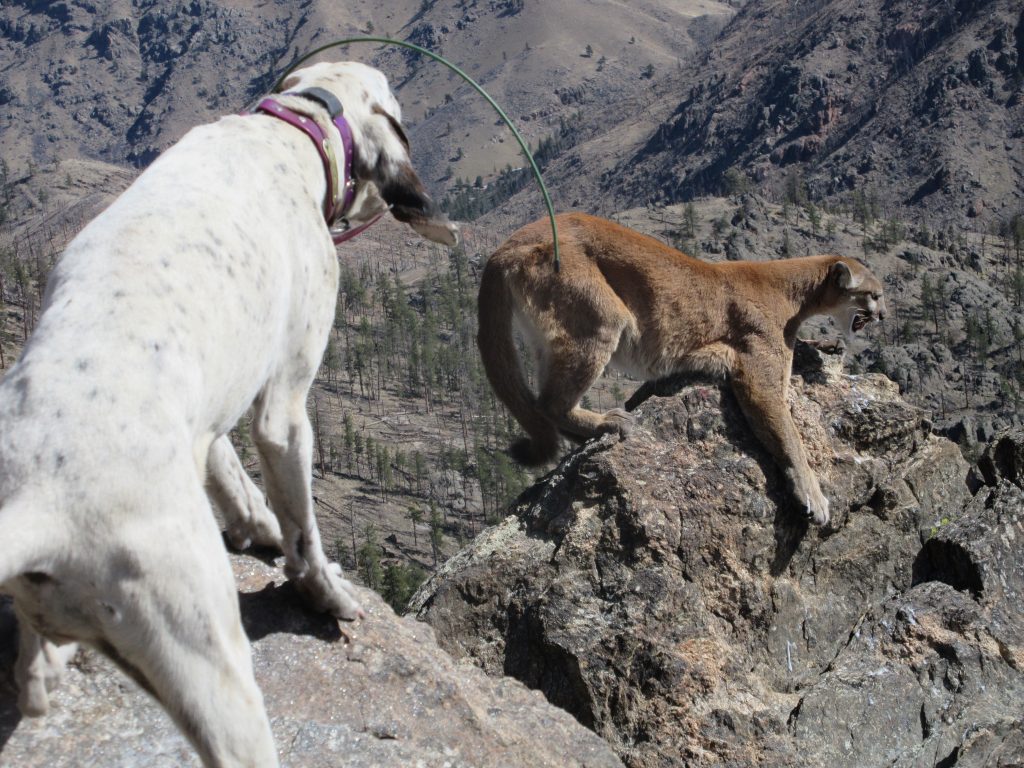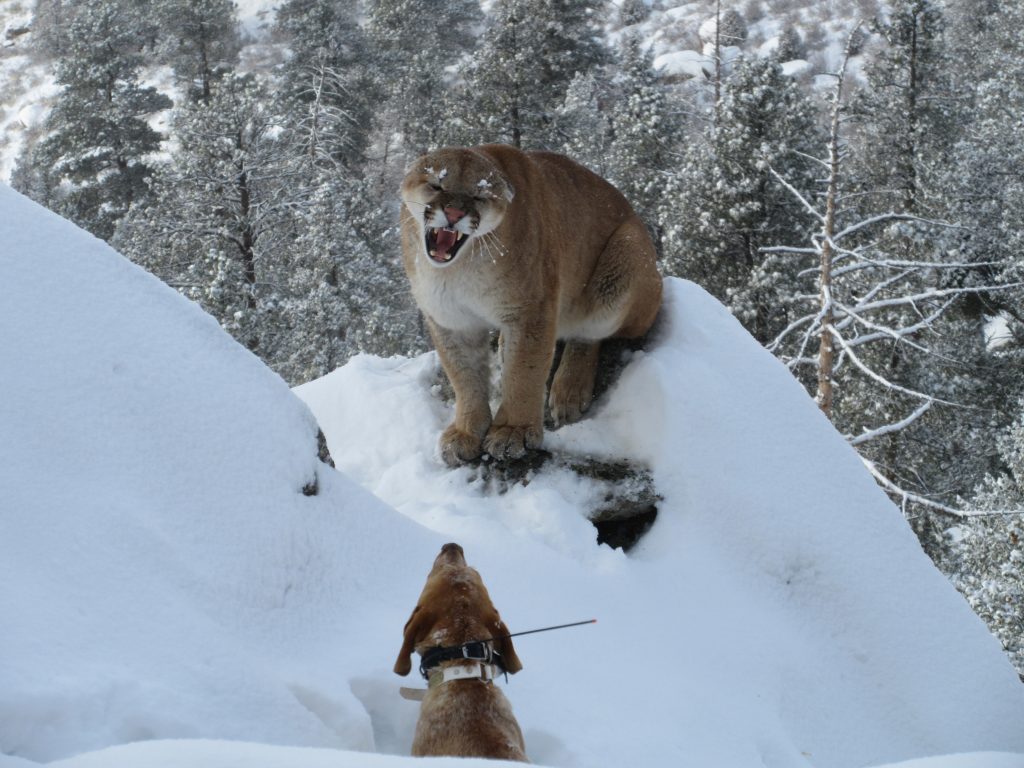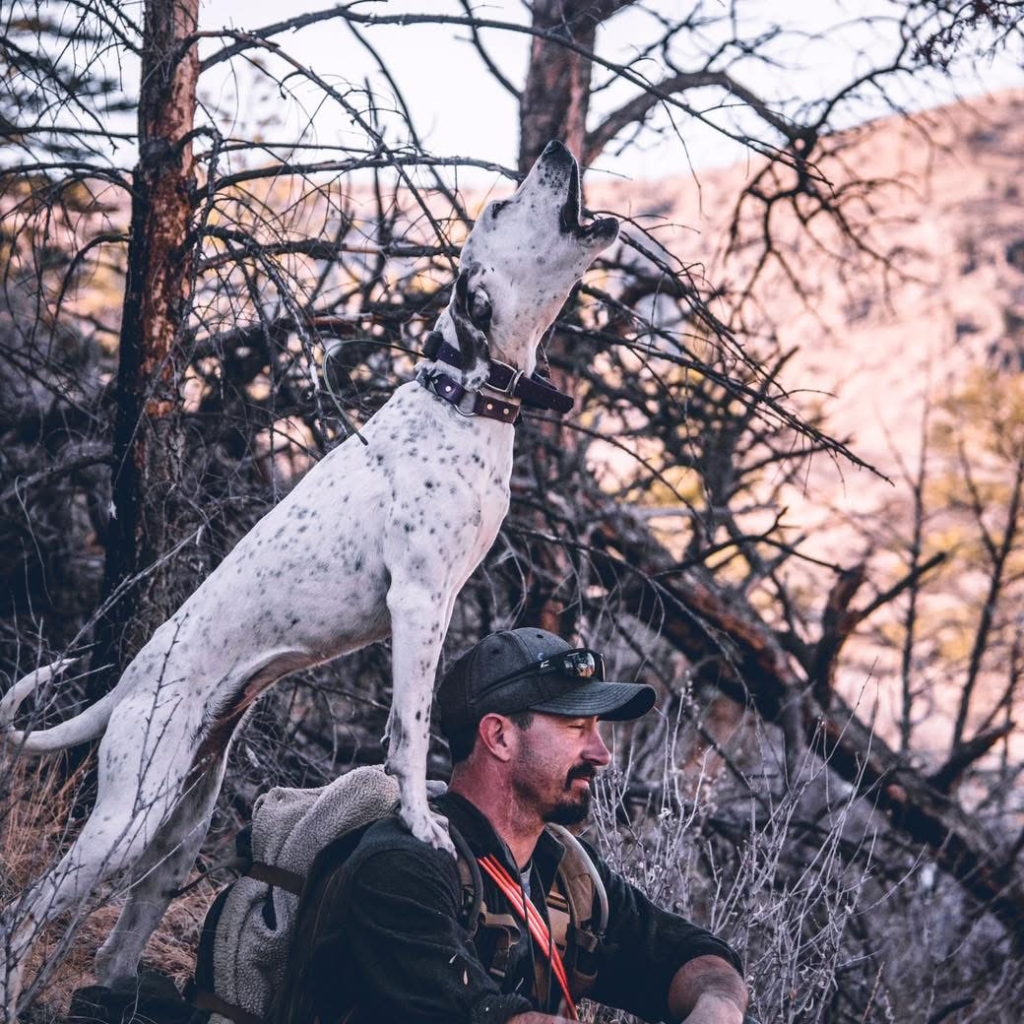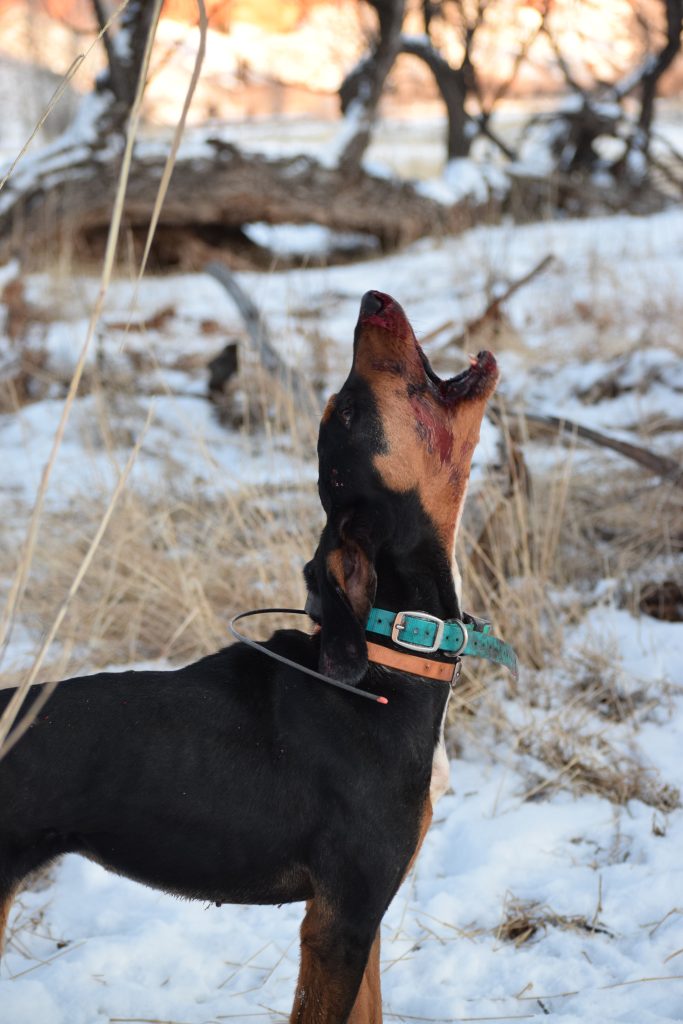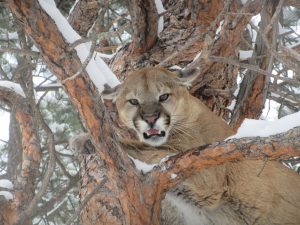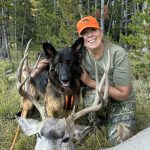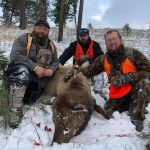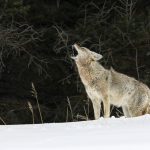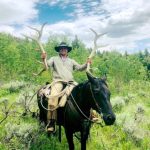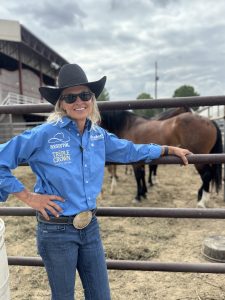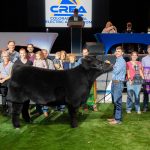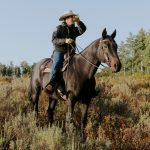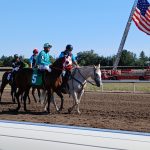Open Season 2025 | Cold Noses and Big Cats
Courtesy photos.
Mountain lion hunters utilize hounds for greatest chance of success
Once a hunter’s rifle is sighted in the way he wants it, he can place it in the safe until such time as he needs it again. Undisturbed, it will be just the same as when he put it away.
Hunting dogs, however, are a much larger commitment to keep “sighted in,” so to speak. The best houndsmen will handle their dogs daily, priming their hunting companions for their next pursuit. Hunting with hounds takes time, patience, training, and trust.
This is how Kody Lostroh of Longmont, Colorado, describes the devotion to the sport of mountain lion hunting. “The commitment is so far beyond other hunting. I don’t think a lot of people even can comprehend it,” he said.
Yet, despite all the work, “any way of hunting with a dog is fun,” said Sandy Forbes of Forbes Outfitters. “Coons, rabbits, I don’t care. If you can train a dog and go hunt with him, that’s a good deal.”
Forbes Outfitters
Forbes Outfitters of Kaycee, Wyoming, provides guide services to numerous types of hunts: elk, mule deer, white tail, antelope, coyotes, prairie dogs, as well as fly fishing.
Mountain lion hunting was his “bread and butter” when he and his wife Penny first got married. Today, this part of his business still carries notoriety.
“I’ve hunted hounds since I was probably 12 years old, and those dogs sucked,” Forbes said. “Whatever I caught, I usually caught them all with my own two feet… but I had hounds there. So I started from the ground up.”
His uncle, Jim Forbes, and Brian Billings helped him along the way. Acquiring superior hounds was the key to success.
Forbes’ dogs derive from bloodlines refined in the southwest by government trappers. “They have good tight feet, and they can travel and get around in the rocks and they handle good. They’re really kind of a cow dog with a really, really cold nose. They’re more of a desert type, hound kind of shorter hair, and the heat doesn’t bother them as bad.”
A dog with a “cold nose” is able to pick up a scent that has “gone cold” in less-than-ideal conditions, such as melted snow, ice, or dirt.
Forbes’ area of Wyoming is open for mountain lion hunting year-round. Other areas in the state have a quota and once the quota is filled, the season ends.
Sheep and cattle ranching are mainstays in Johnson County, and dealing with problem predators is an endeavor that mutually benefits Forbes and local ranchers.
Locals who are dealing with mountain lion depredations call Forbes to locate the problem predator, and Forbes is often able to fill a client’s tag while doing so.
Forbes also assists local Game and Fish departments when there are bear depredations.
Late summer, when a bear’s food sources are diminishing, Forbes is asked to assist. “In August, when the calf elk are growing up big enough to get out of the way of a bear and then when the bugs are dying, the first hatch of grasshoppers are gone and the berries are dried up, those bears go to killing sheep like crazy. So that’s when I get busy with that.”
Forbes brings his entire pack of hounds for bear hunts. “I want to intimidate them quick,” he said. Bears are known to run long distances. While it’s ideal to tree them like a mountain lion, sometimes a bear will “sole up,” comparing it to the behavior of a mad herd bull with cow dogs.
Additionally, bobcat hunting is an exciting offshoot of his outfitting services. Usually, he and his clients carry a bobcat tag just in case the dogs pick up a track.
“It’s exciting,” he said. “[Bobcats] are tricky. They go into the rocks and then up a tree and down a tree, and when you get a bobcat caught, that’s a pretty cool day.”
Kody Lostroh
Kody Lostroh has a long history of companionship with working dogs. “I started with bird dogs, raised those for a long time, and then raised cattle dogs for quite a while, and now we raise hounds,” he said.
While Lostroh used to work as a guide, he now prefers to hunt mountain lions with his friends and family while raising and training his own dogs.
Lostroh had a successful career as a professional bull rider, qualifying to the PBR Finals ten times and being crowned World Champion in 2009. He was a 2023 PBR Ring of Honor inductee, and 2024 Bull Riding Hall of Fame inductee.
A tumor on his carotid artery sidelined him from competition. “When they took it out, it damaged some nerves that go to my eyes that actually are in that same area. And so my eyes work pretty well now, but when things move fast, it gets blurry for me. So that makes it a big problem when it comes to riding bull,” he said.
He ultimately retired in 2018 but continues to work as a coach for the PBR Teams League as head coach of the New York Mavericks.
“Regardless, of all the other symptoms I could have, to only be dealing with that now… that’s awesome. It just unfortunately ended the bull riding.”
Lostroh keeps busy with his other passions. “My main day job is the coaching. I’m always setting up trainings with the guys, working with them, what they need, what we can change, and then dealing with our tours and scheduling and all that stuff. But we also raise cattle and dogs and kids, so they’re all kind of similar things.”
Like Forbes, Lostroh has outsourced his hound’s genetics for the best traits.
“There’s a guy out of Oregon, Mike Kemp, that has been where my breeding program is headed because he’s done it a lot longer than me. He’s been very, very successful. I like his style of dog, and so that’s what I’ve started breeding into my genetics,” Lostroh said.
His are a mix of running dogs and treeing dogs. He explained, “The nuts and bolts of it is a running dog is going to add a little more speed and brains where your treeing dog is going to add some of that better nose and drive to them.
“Think of the English foxhounds, those types of dogs. They’re bred to run and pursue a game that’s up and moving and pursue it very quickly, whereas a treeing dog is bred more to find the scent and go track by track until they get it up and moving and then locate it once it trees.”
These hounds are ideal for his terrain.
“The areas where I hunt and run my dogs is in northern Colorado and up into southern Wyoming. We’re in the Rocky Mountains, which is very aptly named. It’s very rocky.”
Wolves can be a major threat to hunting dogs, so Lostroh takes numerous precautions.
“It’s always a concern of mine when I hear about wolves in different areas, and I’ll even call different game wardens and biologists that I know, especially up in Wyoming, to ask before I go hunt anywhere.
“One thing I have noticed is that areas where wolves have been coming down into Colorado, those particular areas, the mountain lions that live there now are way, way more, I guess, intolerant of dogs than normal. Basically, they get meaner, I think they get meaner, they get tired of getting pushed around by wolves.”
One of the male gray wolves released into Colorado in December 2023 from the Five Points Pack in Oregon, was killed by a mountain lion in April 2024. A female gray wolf killed in April 2025 also died by a mountain lion attack.
“One-on-one, there’s not much that a mountain lion can’t kill. They are incredible killing machines,” said Lostroh.
Training
Both Forbes and Lostroh train their young dogs by letting them run with the older dogs.
“They’ve got the traits that we’re looking for bred into them,” Lostroh said. “They’re going to follow their nose, whether that’s a rabbit, a mountain lion, a moose, a hot dog, whatever. That smells interesting to them. They’re going to go follow that. So my job when they’re young is to get a good handle on them. I’m going to try to hone them in on the scent that I want them to get excited about and make all the other ones not seem near as fun. Once I’ve got a good handle on them, that becomes a lot easier because I can recall them.”
The recall process is crucial for anyone running hounds. It is done through communication between the dog’s collar and a handheld.
“There’s a button I can push, and it makes that collar beep, and we train those dogs to come back to us when they hear that beep, and it is pretty incredible. They could be miles and miles away, but when they hear that beep, they’ll turn around and come right back on their own trail right back to where they last saw you,” Lostroh said.
“The main reason for the collar is safety. I use that thing so often to keep dogs from crossing a busy road or to keep from going onto a landowner’s place where we don’t have permission to hunt and to bring them back if they’re in a bad situation. I’ve even pulled them back when I realized that we were going to catch up to a mountain lion in a place that had no trees. I had young dogs there that weren’t very experienced, and I didn’t want them to end up in a bay up on the ground. So I brought the whole group back. That’s a well-trained animal, right? When they’ve basically got their prey caught and they’re like, okay, I will listen. I’ll come back.”
Lostroh is passionate about educating people about the use of collars for training and hunting.
“The reason I love this topic is because it’s very misunderstood by the general public,” Lostroh said. Though the collars are fixed with a GPS tracker, it does not necessarily make hunting with hounds easier. “I can’t go turn my dogs out in the mountain, come back down and sit and drink coffee all morning until they catch something. That’s not feasible whatsoever.”
The VHF frequency is like that of walkie-talkies, requiring the houndsman to stay within a half mile of his dogs in order to receive a signal. The mountains sometimes provide obstacles. “Then we have to hike higher, ideally, get higher than the dog and then get signal on them again. So it’s not like you always know where your dogs are.”
While Lostroh likes hunting afoot, Forbes prefers to hunt horseback when he’s alone. “I enjoy it best,” he said. When guiding clients, he takes a side-by-side with snow tracks.
Keeping their dogs safe is of utmost importance. A common misconception is that hounds will have direct encounters with lions, but this rarely occurs.
“Nine times out of ten, the lion will go up a tree, but I’ve had them in holes and I’ve had them on rock cliffs,” said Forbes.
Lostroh added, “The job of the dogs is to bring the animal to tree or to bay. Their job is just to stop. There’s never any intent for there to be contact between the dogs and their quarry. They’re there to stop.”
Conditions
Forbes claims that in perfect conditions, mountain lion hunting is simple.
“If you find a really fresh lion track and really fresh snow and you walk it out and you get hardheaded enough to catch that sucker, you will see him eventually, you’ll see that booger.
“But in tough conditions, like in the summertime or if the snow is old or an old track, the hounds are the secret. A seasoned, good hound that’s been hunted hard gets so street smart and so wise to them, rocks and how a cat travels, they’re amazing, the instincts of what they can figure out when they’re hunted hard,” said Forbes.
Lostroh agreed. “The easiest conditions to catch, whether it be a mountain lion or a bobcat or any other game, would be overnight tracks, meaning they happen during the night on a fresh snow. You’ve found these tracks in the morning that’s ideal for the dogs because they can smell at their best when the tracks in the snow hold the scent very well. But things gradually get tougher as that snow ages and starts melting, especially on the south facing slopes, it’ll completely melt a lot of times just in a day or two.”
“We also get to hunt the dirt too, which I absolutely love hunting the dirt, especially in the Rocky Mountains where you’re liable to not even see a track. You’re really relying on the dogs and you’re training, and it is so fun. And in that case, we would either most likely be hiking, find a ridge or a canyon, basically an area where lions like to frequent, and we’ll hike in there and let these dogs run around and sniff, let their noses do the work, and when they find the correct scent, they’ll let us know either by tail wags or bark locate, and then away we go and cross your fingers you’re headed the right direction.”
Stewardship and Family
One of Lostroh’s favorite memories was hunting a mountain lion with his wife and two daughters. One particular lion had killed a deer and was returning to the location to eat. “Typically, that’s a pretty short hunt. They’ll be laid up within a few hundred yards of that deer. Well, this particular one, he went a long way. He laid up way further than normal and it ended up being so far of a walk that my youngest, kept saying, ‘My legs are busy, my legs are busy.’ And she is like six at the time. And when she says ‘busy,’ she means ‘tired’ because that’s what she equated that to being tired in her mind.
“This actually was a pretty tough hunt,” he said. “And then we saw this really unique lion that actually it was missing its tail. I don’t know if it was born that way or if it got injured or it froze off or what. So that was really fun.”
For Lostroh, mountain lion hunting is about the hunt, not about the killing.
“I can’t speak for everybody, but personally, if I am after an animal, it is a specific animal. It’s not just any male. It’s got to be the right one. So that’s what’s really cool about these dogs is if it’s the wrong one, you can leave them in the tree and walk away. And it’s just like most, any other day for a mountain lion, not the first time they’ve been in a tree or chased up a tree, I promise you that.”
Treeing mountain lions gives hunters the opportunity to determine sex and optimal age and size. Females with kittens are off-limits for hunting. They are easily distinguishable by the stain on their belly from where kittens have been suckling.
“Sometimes you’ll see kitten tracks, so if you see little kitten tracks, you just keep going, keep riding, you don’t want to mess with them,” Forbes said.
As with hunting other trophy males of other species, Forbes prefers to guide his clients to the biggest tom cat possible. The size of the track including the pad and toes, as well as the length of his stride can help a hunter determine the size of the lion before he lays eyes on it.
Forbes also has ties to rodeo and agriculture. In the hunting off-season, he works as a PRCA pickup man and helps with the family ranch and Forbes Rodeo Company. He involves his wife and two children in all his endeavors.
For more information about Forbes Outfitters, see forbesoutfitters.net or find them on Facebook.

